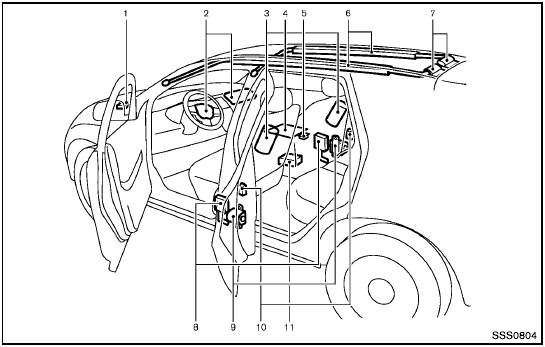 Nissan Rogue: NISSAN Advanced Air Bag System (front seats)
Nissan Rogue: NISSAN Advanced Air Bag System (front seats)

NISSAN Advanced Air Bag System (front seats)
1. Crash zone sensor
2. Supplemental front-impact air bag modules
3. Front seat-mounted side-impact supplemental air bag modules
4. Occupant classification sensor (pattern sensor)
5. Occupant classification system control unit
6. Roof-mounted curtain side-impact and rollover supplemental air bags
7. Roof-mounted curtain side-impact and rollover supplemental air bag
inflators
8. Lap outer pretensioners
9. Seat belt with pretensioners
10. Satellite sensors
11. Air bag Control Unit (ACU)
This vehicle is equipped with the NISSAN Advanced Air Bag System for the driver and front passenger seats. This system is designed to meet certification requirements under U.S.
regulations. It is also permitted in Canada.
However, all of the information, cautions and warnings in this manual still apply and must be followed.
The driver supplemental front-impact air bag is located in the center of the steering wheel; the passenger supplemental front-impact air bag is mounted in the instrument panel above the glove box. The front air bags are designed to inflate in higher severity frontal collisions, although they may inflate if the forces in another type of collision are similar to those of a higher severity frontal impact. They may not inflate in certain frontal collisions. Vehicle damage (or lack of it) is not always an indication of proper front air bag operation.
The NISSAN Advanced Air Bag System has dual stage air bag inflators. The system monitors information from the crash zone sensor, satellite sensor, Air bag Control Unit (ACU), seat belt buckle sensors and occupant classification sensor (pattern sensor). Inflator operation is based on the severity of a collision and seat belt usage for the driver. For the front passenger, the occupant classification sensor is also monitored.
Based on information from the sensors, only one front air bag may inflate in a crash, depending on the crash severity and whether the front occupants are belted or unbelted. Additionally, the front passenger air bag may be automatically turned OFF under some conditions, depending on the information provided by the occupant classification sensor. If the front passenger air bag is OFF, the passenger air bag status light will be illuminated (if the seat is unoccupied, the light will not be illuminated, but the air bag will be off). (See “Front passenger air bag and status light” later in this section for further details.) One front air bag inflating does not indicate improper performance of the system.
If you have any questions about your air bag system, contact NISSAN or a NISSAN dealer. If you are considering modification of your vehicle due to a disability, you may also contact NISSAN. Contact information is contained in the front of this Owner’s Manual.
When a front air bag inflates, a fairly loud noise may be heard, followed by release of smoke.
This smoke is not harmful and does not indicate a fire. Care should be taken not to inhale it, as it may cause irritation and choking. Those with a history of a breathing condition should get fresh air promptly.
Front air bags, along with the use of seat belts, help to cushion the impact force on the head and chest of the front occupants. They can help save lives and reduce serious injuries. However, an inflating front air bag may cause facial abrasions or other injuries. Front air bags do not provide restraint to the lower body.
Even with NISSAN Advanced Air Bags, seat belts should be correctly worn and the driver and passenger seated upright as far as practical away from the steering wheel or instrument panel. The front air bags inflate quickly in order to help protect the front occupants. Because of this, the force of the front air bag inflating can increase the risk of injury if the occupant is too close to, or is against, the air bag module during inflation.
The front air bags will deflate quickly after a collision.
The front air bags operate only when the ignition switch is in the ON position.
After turning the ignition switch to the ON position, the supplemental air bag warning light illuminates. The supplemental air bag warning light will turn off after about 7 seconds if the system is operational.
 Precautions on Supplemental Restraint System
Precautions on Supplemental Restraint System
This Supplemental Restraint System (SRS)
section contains important information concerning
the following systems:
- Driver and passenger supplemental frontimpact
air bag (NISSAN Advanced Air B ...
 Front passenger air bag and status light
Front passenger air bag and status light
Front passenger air bag status light
The front passenger air bag is designed
to automatically turn OFF under some
conditions. Read this section carefully
to learn how it operates. Proper ...
See also:
Bluetooth® functions in the center console control panel
1 Character keys containing letters and
numbers for dialing numbers, adding
phone book entries, etc.
2 TEL: Press this button to activate/deactivate
the Bluetooth® function.
3 TUNE: Turn to ...
Exterior Lamp Controls
The exterior lamp control is on the turn signal/lane change lever.
(Exterior Lamp Control): Operates
the exterior lamps. Turn to one of the following positions:
(Off): Briefly turn to this pos ...
Fluid Capacities
...
